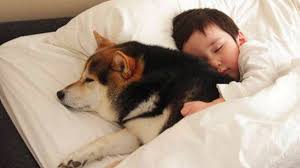This is a sponsored guest post.
A lot of dog owners learn the hard way that pets don’t always respect sleep schedules. We all love our pups, but that doesn’t mean that we also enjoy waking up several times a night to deal with their need for attention.

Dogs take multiple short naps during the day adding up to 12-14 hours on average, so it is unlikely that they’ll remain asleep for the eight hours you need. Even though you cannot control your dog’s daytime naps, you can make changes to his routine and sleeping environment to help her sleep better. Below are six of the most useful tips to help you.
Keep a consistent bedtime routine.
One way to get your dog to sleep and stay asleep is to make him recognize that it is bedtime, and the best way to achieve this is by keeping your dog’s bedtime routine consistent. If you have already established a routine, but your dog still wakes you up every night, you may have to make a few adjustments to the bedtime pattern. Below are a few things to consider:
- Let your pup take a bathroom break before bed.
- Take your dog for a walk then feed him a few hours before bed to help him sleep comfortably on a full tummy.
- Keep the few hours before bedtime relaxed.
- Let your dog sleep with his favourite toy.
Keep your dog active every day.
If your dog roams around at night or refuses to settle down, come bedtime, giving her plenty of exercise during the day will help. If you spend most of your time away from home during the day, you should hire a dog walker to keep your dog active. You can also add a long walk just before bed to ensure a good night’s sleep for both of you.
Remember, the amount of exercise needed by every dog differs depending on their age, breed, and overall health, so be careful not to force your pet into too much activity.
Don’t let your dog sleep on your bed.
Sharing your bed with your pup may seem harmless, but it can seriously affect sleep time for both of you. Your tossing and turning will keep your dog awake, and likewise, her movements will surely disrupt your sleep.
If you don’t want to sleep with your dog in the same bed, but it has separation anxiety,try dog beds for anxiety and set it up near your bed so that you both feel close to each other without disturbing your good night’s sleep.
Set up a comfortable sleeping environment
Just like us, every dog needs a comfortable place to sleep. You can get your pet a comfy dog bed with a warm blanket to keep her cosy all night. You can help your dog doze off quickly with some white noise or any other calming sounds. Also, make sure to put measures to reduce loud noises from outside and keep excessive light out.
Make sure the quality of air inside the room where you sleep with your dog is healthy. You can check HouseholdAir.com for tips how to improve the quality of air in your home.
Consider a medical check-up for your dog.
If your little furry friend still keeps you up after trying all the above, then it’s time to visit the vet. Sometimes restlessness at night is an indication that your dog has an misdiagnose medical condition that needs immediate attention.
Consider your bedtime schedule and routine.
Keeping your sleep routine and schedule consistent will help your dog adapt more quickly. Retiring to bed at midnight every night, for example, will be a lot less confusing to your little pal than if you go to sleep at 11 pm one night and at 3 am on another.
Also, if you have trouble staying asleep all night, try keeping noise at a minimum so that you don’t keep your dog up as well. If your sleep troubles don’t seem to go away, visit a doctor to get the appropriate medical help.
Conclusion
Getting your pup on a consistent and healthy sleep schedule will take more than a few days, but regular training will make a difference. Determine the reason for your dog’s sleepless nights then try out the different methods mentioned above to help you both sleep better every night.




